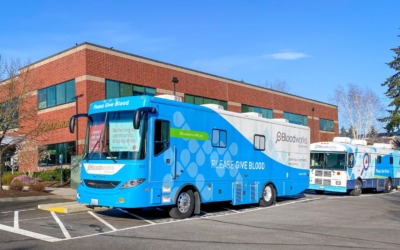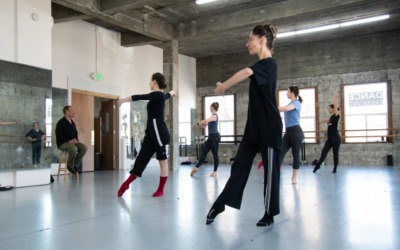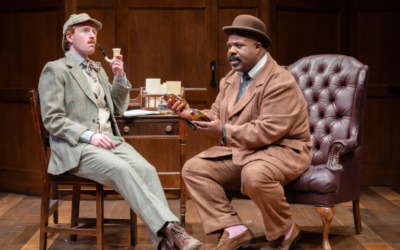As we reported last Friday, neighborhood activists are upset with Fred Meyer’s revamped proposal for an urban village/supercenter store on the current site on 85th Street. While FM has substantially changed the project from its original “big box” design, a volunteer group of local architects and designers thinks the changes are not enough to fit in with the city’s plan for Greenwood/Phinney as an urban village.
Greater Greenwood Design & Development Advisory Group (GGDDAG) members attended last Friday’s presentation at the Greenwood-Phinney Chamber of Commerce meeting, and met immediately afterwards to discuss the project. They sent us their notes from their May meeting with the project’s parties, which architect Evan Bourguard says sums up exactly how they still feel about the project.
We’re reprinting the meeting notes in their entirety, because it gives you a good idea of where many critics of the project are coming from:
Prepared: May 28th, 2009 Meeting Summary & Comments
Meeting Date: May 8th, 2009 Attendees:
GG.DDAG Members (Kate Martin, Evan Bourquard, Trevor Stanley, Jason Morrow, Keith Bates)
Fred Meyer Team
LORIG Development Team (Bruce Lorig, Dayna Dealy)
Landowner team (Gary Brunt)
Architectural Team (Ted Panton, Chris Libby – GGLO)
Meeting Summary: The purpose of the meeting was to compare notes and review the latest development proposal in light of the previous meeting and comments from the GG.DDAG group on April 22nd.
The architectural team presented a revised proposal, including a partially below grade 170,000 sf Fred Meyer retail store, pulled back from the street edges along 3rd, 85th, and 1st to allow for intervening retail uses at grade. The roof of the large retail was reconfigured from the previous scheme to include the garden center of the larger retail, the “open space” was reconfigured to include the FM primary entry. A bridge was added above the Morrow Lane extension to connect the 2nd Ave circulation to terminate in the parking garage. Also the loading area and pedestrian connection at the W end of Morrow was further developed.
Major Points of Concern:
Feasibility: At the meeting there was some discussion of feasibility, given the degree of excavation required for the proposal. The FM team was unable to assure the GG.DDAG that the proposal could go forward as shown, which is a significant cause for concern.
Store Footprint: The store footprint size was again discussed, as it appeared to compromise the circulation through the site and led to some awkward configurations of pedestrian space. GG.DDAG members suggested that given the two story configuration shown, it seemed more possible to stack additional portions of the store to reduce the footprint. The FM team indicated that any reduction in footprint or additional stacking was not possible or feasible.
Overall Clarity: While the proposal includes some positive moments, the overall goal of creating a walkable, bikeable, urban space has not been achieved. Strengthening of grid elements, and further development of public use destination spaces should be explored per comments below. We don’t feel that the neighborhood spaces and open space associated with the project should be perceived as a retail amenity. It is instead, it should feel like a neighborhood amenity.
Suggested Further Development:
The following comments and suggestions on the current proposal correspond to the 12 Development Guidelines provided by the GG.DDAG, and provide suggestions for further development of the scheme based on those ideas.
(The guidelines were included in the previous meeting summary, and are included at the end of this document for reference). Note that these comments are not a complete or all inclusive list of community concerns.
1. Prior Planning: No specific comments
2. Zoning:
a. Please clarify the “contract rezone” configuration being proposed.
3. Open Space:
a. How does this proposal respond to the Green street designation of 1st Ave NW? Expand green spaces along 1st Ave – possibly creating retail spaces that can interface with this green corridor.
b. Additional interior courtyard spaces associated with residential units is a good idea. Increase pedestrian access points to “upper level” and courtyard spaces.
c. Roof is still way too dedicated to parking. Consider higher density buildings and associated private and semi-private spaces. Some of these spaces could also serve as activity areas on the “back side” of the retail along 85th and 1st.
d. Secondary spaces at residential areas seem believable. Use a similar approach to the retail buildings & spaces. See alleyways concept. How does the development connect across to the other rezone sites to the E?
e. See comments under “public realm” below.
4. Grid:
a. We are excited about the revised location of 2nd ave NW to mid block. Additional steps should be taken to improve the viability of that “street” as a primary pedestrian & vehicle circulation path.
b. The North terminus of 2nd Ave NW into the parking garage is not adequate. The bridge used over Morrow lane is of concern as well, as it separates pedestrian areas. 2nd Ave NW should connect to Morrow Ln directly, this would be accomplished by grading the street to meet Morrow to allow pedestrian and vehicle circulation.
c. 2nd Ave NW circulation should extend through the parking garage to 87th to complete the connection. Eroding the store footprint to allow gradual grading to 87th street profile could allow this to happen, which would make the N-S connection to the neighborhood complete.
d. Also of great concern is the W terminus of Morrow Lane. This second primary circulation route is not adequate or urban enough to serve as a viable massing break and corridor. Explore options of subterranean loading function or relocate loading function for the store at the West edge to allow Morrow to connect directly to 3rd.
5. Adjacency:
a. See comments under “grid” regarding continuity of 2nd Ave NW and Morrow Lane. Increased density and height will foster similar development on adjacent sites.
6. Public Realm:
a. The previous scheme had a major destination space located on the parking area on the NE corner of the retail roof. This space is intended to serve as the town center. The current iteration is too related to the garden center and store entry. This space should not be simply a front door to the FM retail space. It should also not be located exclusively on the roof at a level above grade. Refer to earlier comments on this area. Consider a structure or destination that is visible from Morrow looking E from Greenwood. Consider higher density edges at this corner. Consider retail associated with activities on this space. Program for this space may include: farmers market, outdoor movies, etc. Increased green space and planning to associate this area with the conservation area and other “green features” along 1st should be explored.
7. Transit:
a. No specific comments.
8. Compact Mixed Use Development:
a. Current proposal does not meet density goals for the site. Consider higher density buildings or phased development. Plan for structural system above larger retail that can accommodate future phases, or erode store footprint (or stack store) to allow for more high density structures on the site, particularly along 85th and 1st.
9. Service Access:
a. See comments on E end of Morrow under “grid”. Current iteration interferes with continuity of public realm feeling of Morrow at the critical connection to the neighborhood. Relocate FM mechanical/loading.
10. Store Sizes:
a. Increase number and size of retail spaces along the street frontages to ensure more retail diversity. Consider deeper store footprints, or traditional, separated mixed use building development possibilities, especially along 1st ave. Retail spaces along 85th and 1st seem narrow and insignificant. How do these spaces activate the upper plaza? What is viability/vision for these retail spaces?
11. Entrances:
a. Multiple store entrances would be more conducive to site activation, and would encourage pedestrian circulation directly from neighborhood.
12. Parking:
a. Parking is too concentrated. Lots on top or retail store are too large. Consider smaller scale teaser lots more equally distributed around the site.
b. Parking garage should be used by visitors to all of Greenwood, and be designed to be clearly identified as such.
GG.DDAG Project Guidelines:
This is a series of 12 key guidelines for the development of this site and the surrounding parcels, as developed by the volunteers of the GG.DDAG.) Note: In general, please note that these comments can only serve as a preliminary guide because the Rezone Proposal and Case Study are still in draft form.
1. Prior Planning – Growth Management Act, Seattle’s Comprehensive Plan & the Urban Village Strategy, Neighborhood Plan – Respect and respond to all elements of Seattle’s Comprehensive Plan including but not limited to all policies & strategies relevant to Residential Urban Villages.
2. Zoning: Zoning designations are still being discussed internally by GGLUDD in order to determine which zoning designation is most consistent with the mixed use / neighborhood commercial intent and pedestrian / bicycle / transit rider modal preference over auto dominance of Residential Urban Villages as per the Comprehensive Plan and Neighborhood Plan. NC2 40, NC2 65, and ways to further incentivize compact mixed use walkable, bikeable development.
3. Open Space: Identify and develop a hierarchy of people-centered programmable open spaces for public use around which the town center can develop and connect to the main streets. Consider termination of Morrow Lane at a town square. Create a sense of place by scaling the town square properly, detailing it with dignity, and defining the space sufficiently with buildings that interact with the space. Plan for a variety of open spaces that optimize solar orientation and are protected from wind. Address the needs of all ages of users in the varied open spaces including but not limited to play spaces, seating areas, public gathering spaces, green spaces and a town square where a flea market / street market could occur regularly. Consider a landmark in the town square and plan for adjacency of some surface parking to accommodate flea / street market vendors.
4. Grid: Create an at-grade exterior walkable / bikeable circulation system with a maximum 300’x 300’ grid. Bisect / Supplement main grid with a finer grain circulation system of alleyways for service, pedestrians, and bikes. Align and re-establish 2nd Ave NW. Plan for a mid-block crosswalk at 2nd Ave N across NW 85th St . Respect Green Street designation of 1st Ave NW.
5. Adjacency: Connect the development seamlessly with the existing streets and adjacent development
6. Public Realm: Concentrate on the quality of the space in the public realm even if it’s actually privately owned. Street trees, wide sidewalks, attractive pavement, buildings that are interesting at the pedestrian level, site furnishings, and comfortable spaces that encourage foot traffic, transit use, and bicycles should all be considered.
7. Transit: Address importance of NW 85th St as a Pedestrian Overly Zone. Plan to accommodate a very integrated, welcoming, attractive and comfortable transit stop on NW 85th St.
8. Compact Mixed Use Development: Promote healthy human habitat including family habitat and senior habitat with compact mixed income mixed-use development across the site. Develop 4 – 6 story buildings that result in density of 30 – 50 HH / acre. In general, development that is sustainable economically, socio-culturally, and environmentally should be fully explored.
9. Service Access: Create service access from alleys and below grade as possible (depending on Peat Settlement Zone implications). Consider small parking pockets in alleys for short term use.
10. Store Sizes: Create a variety of commercial spaces including retail, services, community uses, and offices. Create a variety of sizes that conform to NC 2 guidelines.
11. Entrances: Provide entries to commercial and residential spaces along all building facades on the main grid at grade. Consider space between sidewalks and doors that allow the commercial spaces to interact with / spill out onto the sidewalk and allow residential uses a transition area between public and private space. . Consider 4 second changes for pedestrian level experience along sidewalks. Include a minimum of one entrance per 25,000 sf of single use commercial space.
12. Parking: Provide residential and employee parking below grade if possible (depending on Peat Settlement Zone implications). Incentivize employees that arrive on foot, bicycles and via transit. Provide commercial parking in a “tenant neutral” structured mixed use garage or garages above grade and open to daylight that can function as shared parking for the larger business district including the existing commercial uses on the main streets. Provide universally accessible surface parking in small teaser lots that reduce distances for off-peak shopping by mobility impaired customers and seniors. Connect teaser lots to structured parking. Provide convenient bike parking throughout the site.
Thank you for this opportunity to provide guidelines for development of the site. Greater Greenwood Design and Development Advisory Group (GG.DDAG) Contact us at: [email protected].




